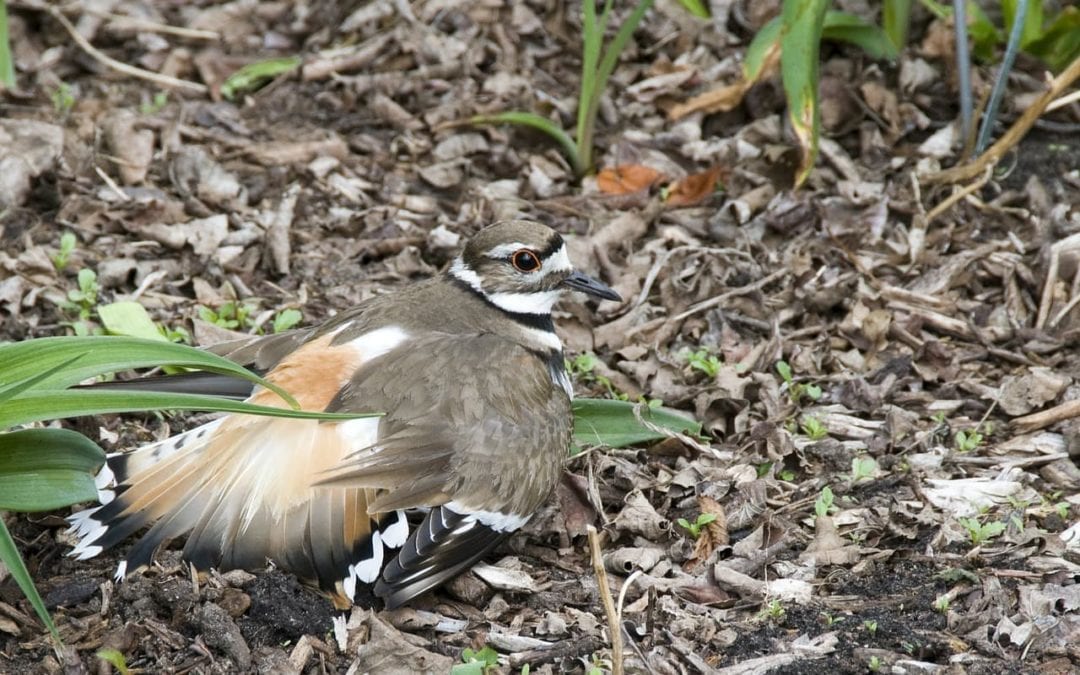I see them every day, this time of year, on my way to work. Most mornings, I stop in a church parking lot for a few stolen moments before the hustle and bustle of veterinary medicine and surgery. There is a pair of killdeer that play on the pavement.
Killdeer are small birds about the size of a robin. They have a large, round head, and large eyes. The short bill is for eating insects. They feed on a wide variety of insects, including beetles, caterpillars, grasshoppers, fly larvae, and many others. They also eat spiders, earthworms, centipedes, crayfish, snails and a small amount of seeds.
I think they stand out the most because of their long, even lanky legs with a long, pointed tail and long wings. The birds are brownish-tan on top with white bellies. The white neck area is barred with two black bands in the adults, but only one band in the babies. The brown face is marked with black and white patches. They have a bright orange-buff butt that is conspicuous in flight. Killdeers are named for their very distinctive cry. The unique call is a high-pitched whistle that sounds like “keel-deer!”
I don’t remember seeing killdeer when I was young, but they are listed as common throughout the southern United States. I first remember seeing them in Mizzou’s vet school parking lot. The gravel lot was at the bottom of the hill with wooded area and fields around. It was a rapid, long hike to the classes and I never really had time to stop and look at the strange birds. I would see them scurrying around the lot as I scurried up the hill. In the spring there would soon be some road construction sawhorses blocking off a ground nest. I never bothered the nest and apparently neither did my classmates, because a little while later there would be several smaller birds with the adults.
Where we do wildlife rehab, we often gets calls about baby birds and nests that have blown down. Usually we just tell people to nail a plastic bowl with drain holes, in a tree and put the nest up off the ground. (Only vultures have a strong sense of smell.) The noisy birds will call their parents to the new nest. This particular caller said “There are no trees around.” This didn’t sound quite right. Questioning more, they said that they found the nest in the gravel of a storage lot area. We asked them to text in a photo and received a beautiful photo of a killdeer nest. We explained that was the normal place for that species and they should leave it alone or even put a cone around it. I hope they actually did.
Killdeer are common shorebirds but have also adapted to offshore environments like golf courses, sports fields and parking lots. The nest is often a simple slight depression in the ground – they prefer gravel terrain. The speckled eggs camouflage well among the gravel, but the young are openly exposed. The killdeer has a unique way to ward off potential threats. That same orange patch that shows up in flight is part of their “broken-wing routine.” This is a predator distraction technique. When a killdeer thinks there is a threat to their nest, the killdeer holds the wing down, flashes the orange patch and pretends to have a broken wing. This draws attention away from its eggs or young. After the threat is directed far enough from the nest, the bird simply flies away
Only recently did I learn that these birds were killdeer. My early birding knowledge happened when I was in the Coast Guard. The killdeer looked similar to the sandpipers that had been in the coastal areas, but they are not closely related. Killdeers are a North American plover (Charadrius vociferus ) and a sandpiper is any of various small wading birds of the family Scolopacidae. Long legs and small bodies, but from a different family.
A friend of mine said they were called tilt, uh, tilt-butts, because they would tilt their hindquarters up in the air and run. My friend came from a long time in law enforcement and didn’t actually use the word butt, but I could see how that would be appropriate. They do run well with their heads down.
As I look across at the creek and the open field with the wooded mountains behind, my eyes are drawn back to the nearer killdeer. A parent must think I am too close, because the wing is down, the orange patch is up and it even looks like the killdeer is limping. If I was a predator, I would definitely go for the wounded bird over the tiny morsel of egg or chick. Since I am not hungry for plover, I smile at their antics and then head to work.

